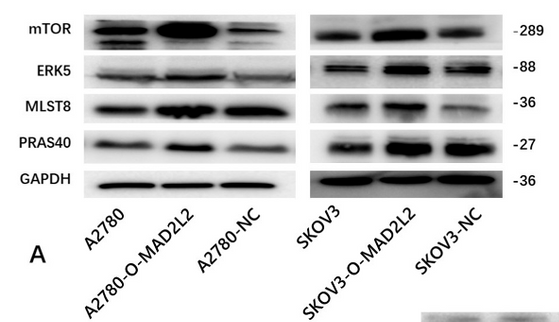MLST8 Antibody - #DF6204
| Product: | MLST8 Antibody |
| Catalog: | DF6204 |
| Description: | Rabbit polyclonal antibody to MLST8 |
| Application: | WB IHC IF/ICC |
| Cited expt.: | WB |
| Reactivity: | Human, Mouse, Rat, Monkey |
| Prediction: | Pig, Zebrafish, Bovine, Sheep, Rabbit, Dog, Chicken, Xenopus |
| Mol.Wt.: | 36kDa; 36kD(Calculated). |
| Uniprot: | Q9BVC4 |
| RRID: | AB_2838170 |
Related Downloads
Protocols
Product Info
*The optimal dilutions should be determined by the end user. For optimal experimental results, antibody reuse is not recommended.
*Tips:
WB: For western blot detection of denatured protein samples. IHC: For immunohistochemical detection of paraffin sections (IHC-p) or frozen sections (IHC-f) of tissue samples. IF/ICC: For immunofluorescence detection of cell samples. ELISA(peptide): For ELISA detection of antigenic peptide.
Cite Format: Affinity Biosciences Cat# DF6204, RRID:AB_2838170.
Fold/Unfold
G protein beta subunit like; G protein beta subunit-like; Gable; GbetaL; GBL; GBL protein; LST8; LST8_HUMAN; Mammalian lethal with SEC13 protein 8; MGC111011; mLST8; MTOR associated protein LST8 homolog (S. cerevisiae); POP3; POP3 homolog (S. pombe); Protein GbetaL; Target of rapamycin complex subunit LST8; TORC subunit LST8; WAT1; WAT1 homolog (S. pombe);
Immunogens
A synthesized peptide derived from human MLST8, corresponding to a region within the internal amino acids.
- Q9BVC4 LST8_HUMAN:
- Protein BLAST With
- NCBI/
- ExPASy/
- Uniprot
MNTSPGTVGSDPVILATAGYDHTVRFWQAHSGICTRTVQHQDSQVNALEVTPDRSMIAAAGYQHIRMYDLNSNNPNPIISYDGVNKNIASVGFHEDGRWMYTGGEDCTARIWDLRSRNLQCQRIFQVNAPINCVCLHPNQAELIVGDQSGAIHIWDLKTDHNEQLIPEPEVSITSAHIDPDASYMAAVNSTGNCYVWNLTGGIGDEVTQLIPKTKIPAHTRYALQCRFSPDSTLLATCSADQTCKIWRTSNFSLMTELSIKSGNPGESSRGWMWGCAFSGDSQYIVTASSDNLARLWCVETGEIKREYGGHQKAVVCLAFNDSVLG
Predictions
Score>80(red) has high confidence and is suggested to be used for WB detection. *The prediction model is mainly based on the alignment of immunogen sequences, the results are for reference only, not as the basis of quality assurance.
High(score>80) Medium(80>score>50) Low(score<50) No confidence
Research Backgrounds
Subunit of both mTORC1 and mTORC2, which regulates cell growth and survival in response to nutrient and hormonal signals. mTORC1 is activated in response to growth factors or amino acids. Growth factor-stimulated mTORC1 activation involves a AKT1-mediated phosphorylation of TSC1-TSC2, which leads to the activation of the RHEB GTPase that potently activates the protein kinase activity of mTORC1. Amino acid-signaling to mTORC1 requires its relocalization to the lysosomes mediated by the Ragulator complex and the Rag GTPases. Activated mTORC1 up-regulates protein synthesis by phosphorylating key regulators of mRNA translation and ribosome synthesis. mTORC1 phosphorylates EIF4EBP1 and releases it from inhibiting the elongation initiation factor 4E (eiF4E). mTORC1 phosphorylates and activates S6K1 at 'Thr-389', which then promotes protein synthesis by phosphorylating PDCD4 and targeting it for degradation. Within mTORC1, LST8 interacts directly with MTOR and enhances its kinase activity. In nutrient-poor conditions, stabilizes the MTOR-RPTOR interaction and favors RPTOR-mediated inhibition of MTOR activity. mTORC2 is also activated by growth factors, but seems to be nutrient-insensitive. mTORC2 seems to function upstream of Rho GTPases to regulate the actin cytoskeleton, probably by activating one or more Rho-type guanine nucleotide exchange factors. mTORC2 promotes the serum-induced formation of stress-fibers or F-actin. mTORC2 plays a critical role in AKT1 'Ser-473' phosphorylation, which may facilitate the phosphorylation of the activation loop of AKT1 on 'Thr-308' by PDK1 which is a prerequisite for full activation. mTORC2 regulates the phosphorylation of SGK1 at 'Ser-422'. mTORC2 also modulates the phosphorylation of PRKCA on 'Ser-657'.
Cytoplasm.
Broadly expressed, with highest levels in skeletal muscle, heart and kidney.
Belongs to the WD repeat LST8 family.
Research Fields
· Cellular Processes > Transport and catabolism > Autophagy - other. (View pathway)
· Cellular Processes > Transport and catabolism > Autophagy - animal. (View pathway)
· Environmental Information Processing > Signal transduction > mTOR signaling pathway. (View pathway)
· Environmental Information Processing > Signal transduction > PI3K-Akt signaling pathway. (View pathway)
References
Application: WB Species: Human Sample:
Restrictive clause
Affinity Biosciences tests all products strictly. Citations are provided as a resource for additional applications that have not been validated by Affinity Biosciences. Please choose the appropriate format for each application and consult Materials and Methods sections for additional details about the use of any product in these publications.
For Research Use Only.
Not for use in diagnostic or therapeutic procedures. Not for resale. Not for distribution without written consent. Affinity Biosciences will not be held responsible for patent infringement or other violations that may occur with the use of our products. Affinity Biosciences, Affinity Biosciences Logo and all other trademarks are the property of Affinity Biosciences LTD.






